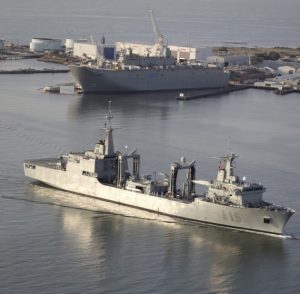- Author
- Editorial Staff
- Subjects
- History - general, Ship histories and stories
- Tags
-
- RAN Ships
- None noted.
- Publication
- March 2014 edition of the Naval Historical Review (all rights reserved)
Spanish guests are only infrequently welcomed to our shores, in fact this seems to occur about every 200 years. The famous navigator Luis Vaz de Torres visited in 1606 and two centuries later in the early 1800s, Spanish prizes taken by privateers off the Pacific coast of South America started to appear at Port Jackson. These included the handsome schooner Bethlehem which for a time wore the broad pennant of Commodore Bligh. Another 200 years have passed and we have discovered the wonders of Spanish shipbuilding, leading to the invaluable loan of a Spanish naval ship to the RAN.
The following comments on this important historic event have been taken from a number of sources including Navy News and Reveille – the RSL, NSW Branch magazine.
One of the perhaps more surprising long-term maritime guests who stayed with us last year was the Spanish Armada ship SPS Cantabria which arrived in January and didn’t finally depart until November 2013, after taking part in the International Fleet Review. Cantabria was commissioned in 2010 and at 19,550 displacement tons is the second-largest ship operated by the Spanish Armada. There was good reason for the combat logistics ship to be here as there was a gap in the fleet with the RAN’s east coast fleet replenishment ship HMAS Success undergoing an extensive refit. This important fleet replenishment role could not remain unfilled with Cantabria performing 63 replenishments.

The Chief of Navy VADM Ray Griggs told Navy News that Cantabria’s deployment was a result of the excellent relationship between the Spanish Armada and the RAN. This had developed since ‘we became customers of the Spanish ship-building industry’.
Cantabria had done a great job for the RAN. ‘Cantabria has served as part of the fleet since February and has participated in a range of important exercises including Exercise Talisman Saber, Exercise Triton Centenary and the International Fleet Review,’ said Admiral Griggs. ‘Cantabria also provided 234 Navy personnel with the opportunity to familiarise themselves with the systems that will equip the new Canberra-class LHDs and the Hobart-class destroyers.’
RSL secretary Chris Perrin takes up the story: ‘We will take delivery of five ships of Spanish design in a matter of a few years. Rear Admiral Tim Barrett, Commander of the Australian Fleet, arranged for the loan of Cantabria. The clever part here is that being only a couple of years old, Cantabria has the same equipment and systems as the Spanish-designed Australian ships.’
But the crushingly difficult part for the crew of Cantabria was the world financial crisis which hit Spain hard, so hard that the Armada was forced to either lose half its personnel or for all to take a 50 per cent pay cut. That’s what happened and so the Cantabria sailed off to Sydney and her ship’s company to the sixth most expensive city in the world on only half-pay.
There was to be a silver lining. The RAN arranged with the RSL state branch for help in entertaining the ship’s company at weekends and of course that help was swift. The staff of ANZAC House gave up their weekends to help entertain the Spanish sailors. There were movie tickets, stage shows, sightseeing, abseiling and caving in the Blue Mountains, a bridge climb and even visits to the Central Coast Reptile World where snake and spider milking were especially popular.
Cantabria was due at her home port of Ferrol in time for Christmas, with a Red Kangaroo mounted to mark honorary Australian status. Commanding Officer Jose Luis Nieto, thanking all those who helped, recalled that Spanish Captain Luis Vaez de Torres recorded sailing through the strait that bears his name, four hundred years ago in 1606. So the Spain/Australia link has endured a very long time.
LSET Alvaro Pazos said: ‘I am happy to be going home because I miss my family, but I will never forget the friendships I made here with sailors in the RAN. It surprised me how similar we are and how well we got on, when we did our jobs together or when we relaxed together.’ RAN training systems officer LEUT Christopher Thornton said: ‘It’s just spectacular to work with another navy and they have the same outlook as us – ‘no worries’.’
¡Viva el Cantabria! ¡Viva Australia! ¡Viva España!




